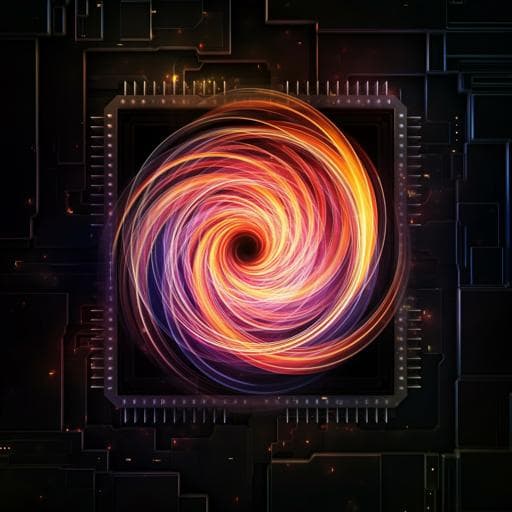
Physics
A von-Neumann-like photonic processor and its application in studying quantum signature of chaos
S. Yu, W. Liu, et al.
This revolutionary research introduces a von-Neumann-like photonic processor that leverages temporal-mode encoding for enhanced programmability, efficiency, and stability. The findings, spearheaded by a team of researchers from the University of Science and Technology of China, showcase its application in studying chaotic systems and quantum behaviors, positioning it as a potential game-changer in real-world technologies.
~3 min • Beginner • English
Introduction
The paper addresses limitations in current photonic quantum processors, where achieving both low loss and multimode-universal programmability (MM-universal) is challenging. Bulk (on-table) optics typically have lower loss but limited programmability and scalability, whereas integrated photonics offer compactness but suffer from higher loss, crosstalk, and resource overhead for large programmable circuits. The authors propose a von-Neumann-like (Harvard-like) photonic processor architecture that uses temporal-mode encoding and a looped structure with a quantum delay-line memory to enable MM-universal programmability with resource efficiency, phase stability, and software scalability. They aim to demonstrate practical programmability on a single platform by compiling and running two quantum programs that probe quantum signatures of chaos: (1) visualizing phase-space dynamics via Husimi distributions in the quantum kicked top (QKT) and (2) quantitatively testing the Fermi golden rule (FGR) via average fidelity decay, an experiment not previously performed quantitatively.
Literature Review
The authors review linear-optical quantum computing, starting with the Knill-Laflamme-Milburn (KLM) paradigm utilizing measurement-induced nonlinearity and Hong-Ou-Mandel interference. They note the non-deterministic nature of the nonlinear sign (NS) gate and consequent controlled-phase (CZ) gate, and outline strategies toward near-deterministic behavior via teleportation with entangled ancillae or memory-based repeated operations. Cluster-state (one-way) computation is highlighted but remains resource-intensive. Boson Sampling, including Scattershot and Gaussian Boson Sampling (GBS), has demonstrated quantum advantage, and GBS has practical links to graph problems and molecular dynamics, expanding beyond a mere computational game. The authors emphasize MM-universal programmability of multimode unitary interferometers as crucial for applications (including in GBS contexts) but historically traded off against loss. They contrast integrated photonics (compact, but with loss, heating, and crosstalk) and bulk optics (lower loss), and note that most prior MM-universal programmable processors are unlooped and resource-heavy, with the largest MM-universal system around 20 modes with 380 phase shifts, insufficient to show advantage.
Methodology
Architecture: The processor follows a von-Neumann/Harvard (VH) architecture adapted to photonics, employing temporal-mode encoding and a looped optical path. A delay-line quantum data memory buffers temporal modes between repeated interactions with a processor unit. An instruction memory outputs digital and analog control signals that reconfigure gates each loop.
Processor unit: Comprised of five electro-optic modulators (EOM1–EOM5). EOM1 and EOM5 are digitally switched for temporal-mode addressing (routing/selecting modes). EOM2–EOM4 apply continuously tunable phase shifts and couplings to implement arbitrary two-mode operations and synthesize general multimode unitary transformations per instructions. The full optical path forms a large circulation enabling repeated gate applications with the same hardware (software reprogramming per loop).
Temporal modes: Photonic qudits are encoded across time bins. Pulses before the entrance PBS are inputs; after an AOM they are outputs. Temporal-mode encoding offers intrinsic phase stability and insensitivity to slow drifts and spatial inhomogeneities, facilitating long loop depths and reduced resource overhead.
Programming/compilation: Target evolutions are decomposed into sequences of two-level (two-mode) gates and phase shifts scheduled over loop iterations. For the quantum kicked-top model (QKM), the Floquet operator U = exp(-i n J_y/2) exp(-i k J_x^2 / j) is compiled via Trotter expansion into nine layers of two-level operations plus one phase layer per period. Instruction sequences (one period) are iterated to reach desired evolution depth.
Program 1 (Phase-space visualization): Implements QKM with spin j = 6 (dimension 2j+1 = 13 temporal modes). The program creates 13 modes and executes n = 4 periods of U. Initial states are SU(2) coherent states; s = 35 randomly chosen initial coherent states are evolved, and after each period i (0 ≤ i ≤ n), density matrices are reconstructed (or measured) to compute Husimi Q distributions R(θ,φ) = ⟨θ,φ|ρ|θ,φ⟩ and average them over the set to obtain Q(θ,φ), allowing visual comparison between regular (k = 1) and chaotic (k = 12) dynamics.
Program 2 (FGR via average fidelity decay): Extends Program 1 by duplicating the 13-mode evolution to include a perturbed channel U_P = U with a perturbation P = exp(-i δ), giving a total of 26 temporal modes implementing a controlled evolution with an ancilla qubit (Hadamard test). Preparing the qudit in a maximally mixed state (effectively averaging over initial states) allows direct extraction of average fidelity F_i = overline[⟨Φ_0| (U†)^i (U_P)^i |Φ_0⟩] by measuring ⟨σ_z⟩ of the ancilla after i periods (0 ≤ i ≤ 6). The decay of ln F_i with i is examined for different k and perturbation strengths δ. Trotter-expanded implementations are used for both U and U_P, and repeated runs (5 repeats) provide error bars.
Hardware considerations: The looped, on-table bulk optics implementation targets low optical loss, high phase stability, and software scalability. The architecture supports a large number of effective phase controls through time-multiplexing; the largest compiled program corresponds to an interferometer network with 1694 freely adjustable phases. One-period processor fidelity exceeds 0.992.
Key Findings
- The proposed VH-like temporal-mode photonic processor achieves MM-universal programmability with resource efficiency, phase stability, and software scalability in a bulk optical looped architecture.
- Program 1 (13 modes, j = 6, n = 4 periods): Averaged Husimi distributions reveal clear qualitative differences between regular (k = 1) and chaotic (k = 12) regimes of the quantum kicked-top. Chaotic dynamics produce much more uniform (dispersive) phase-space distributions than regular dynamics.
- Processor performance: One-period fidelity exceeds 0.992. The largest compiled program corresponds to an interferometric network with 1694 freely adjustable phases, demonstrating substantial programmable complexity with limited hardware.
- Program 2 (26 modes with ancilla-assisted Hadamard test): The average fidelity F_i between unperturbed and perturbed evolutions exhibits behavior consistent with the Fermi golden rule (FGR) in the chaotic regime. For k = 12 (chaotic), ln F_i decays linearly with the number of periods i (within Trotterization errors), matching theoretical predictions including Trotter-expanded models. For k = 1 (regular), the decay deviates from exponential after i = 3 and stabilizes, as expected outside the FGR regime. Results are averaged over effectively maximally mixed initial states and repeated 5 times to extract uncertainties.
- The study provides, to the authors’ knowledge, the first quantitative experimental confirmation of the FGR behavior in this context using a photonic processor.
Discussion
The work demonstrates that a von-Neumann/Harvard-like, temporally encoded, looped photonic architecture can deliver MM-universal programmability while mitigating loss and stability issues that hinder large-scale programmable photonics. By compiling complex evolutions through time-multiplexed EOM controls and a delay-line memory, the same hardware executes distinct programs with significantly different resource demands. The phase-space Husimi visualizations directly capture the hallmark spreading of chaotic dynamics versus localization in regular regions. The controlled two-channel experiment confirms that in the chaotic regime the averaged state fidelity decays exponentially with evolution depth—consistent with the FGR—and deviates from this behavior in the regular regime. Agreement between experimental data and Trotter-expanded theoretical predictions, despite known Trotter errors, validates both the simulation approach and the processor’s fidelity. These results indicate the platform’s suitability for studying complex quantum dynamics and benchmarking quantum simulators, and point toward applicability in real-world computational tasks that demand large, reconfigurable unitary evolutions.
Conclusion
The authors introduce a von-Neumann-like photonic processor based on temporal-mode encoding and a looped memory-processor architecture, achieving MM-universal programmability with high fidelity and resource efficiency on a bulk-optics platform. They demonstrate versatility by running two distinct quantum programs on the same processor: (1) visualization of regular vs. chaotic dynamics in the quantum kicked-top via Husimi distributions using 13 temporal modes, and (2) a quantitative test of the Fermi golden rule via ancilla-assisted average fidelity measurements using 26 modes. Experimental results in the chaotic regime align with FGR predictions, while regular dynamics deviate from exponential decay, thereby providing a quantitative experimental study of chaos signatures. The architecture scales in software to large interferometric complexity (up to 1694 adjustable phases) and offers phase stability and low loss, making it a promising candidate for practical photonic quantum information processing and near-term applications. Future work could scale mode count and loop depth, further reduce loss, integrate improved quantum memories and sources, and target application domains such as complex graph problems, molecular modeling, and other quantum simulation tasks.
Limitations
- The detailed affiliation list for all author superscripts beyond the first two provided affiliations is not available in the excerpt.
- The implemented evolutions rely on Trotter decompositions, introducing systematic deviations from ideal dynamics; these are acknowledged and observed as systematic fidelity offsets relative to ideal theory.
- While the looped architecture mitigates loss relative to integrated photonics, overall performance and scalability remain constrained by cumulative optical loss and memory efficiency as the number of modes and loop depth increase.
- Quantitative results for the dependence of decay rate on perturbation strength δ are referenced but not fully presented in the provided text segment, limiting comprehensive reporting of that analysis here.
Related Publications
Explore these studies to deepen your understanding of the subject.







